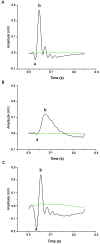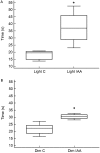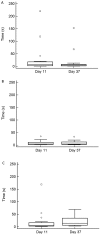Behavioral Assessment of Vision in Pigs
- PMID: 29966544
- PMCID: PMC6059216
- DOI: 10.30802/AALAS-JAALAS-17-000163
Behavioral Assessment of Vision in Pigs
Abstract
Swine (Sus scrofa) are often the 'gold standard' laboratory animal for ophthalmology research due to the anatomic and physiologic similarities between the porcine and human eye and retina. Despite the importance of this model, few tools for behavioral vision assessment in pigs are available. The aim of this study was to identify and validate a feasible and reproducible behavioral test to assess vision in a pig model of photoreceptor degeneration. In addition, a robust behavioral test will reduce stress and enhance enrichment by allowing animals opportunities for environmental exploration and by reducing the number of invasive experimental procedures. Two distinct behavioral approaches were tested: the obstacle-course test and temperament test. In the obstacle-course test, pigs were challenged (after an initial training period) to navigate a 10-object obstacle course; time and the number of collisions with the objects were recorded. In the temperament test, the time needed for pigs to complete 3 different tasks (human-approach, novel-object, and open-door tests) was recorded. The obstacle-course test revealed significant differences in time and number of collisions between swine with vision impairment and control animals, and the training period proved to be pivotal to avoid bias due to individual animal characteristics. In contrast, the temperament test was not altered by vision impairment but was validated to measure stress and behavioral alterations in laboratory pigs undergoing experimental procedures, thus achieving marked refinement of the study.
Figures





References
-
- Antognazza MR, Di Paolo M, Ghezzi D, Mete M, Di Marco S, Maya-Vetencourt JF, Maccarone R, Desii A, Di Fonzo F, Bramini M, Russo A, Laudato L, Donelli I, Cilli M, Freddi G, Pertile G, Lanzani G, Bisti S, Benfenati F. 2016. Characterization of a polymer-based, fully organic prosthesis for implantation into the subretinal space of the rat. Adv Healthc Mater 5:2271–2282. 10.1002/adhm.201600318. - DOI - PubMed
Publication types
MeSH terms
LinkOut - more resources
Full Text Sources
Other Literature Sources

